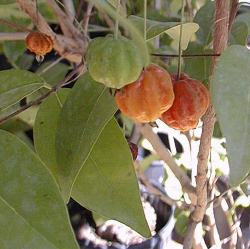Sunset®: 21-27
USDA: 10-12
Frost Tolerance: Semi hardy in Phoenix, should be protected for the coldest nights, foliage damaged at 28° F (-2° C), serious damage at 24° F (-5° C)
Sun Exposure: Full sun or light shade
Origin: Brazil
Growth Habits: Compact shrub or small tree, slowly up to 20 feet (6 m) usually smaller
Watering Needs: Regular water
Propagation: Seeds, cuttings, cleft graft

Surinam Cherry fruits
Unlike most other members of this genus, which are native to southeastern Asia, the Surinam Cherry is indigenous to tropical Brazil. It d\forms a large shrub or a small tree approximately 20 feet in height. The small, opposite, ovate-lanceolate leaves are glossy green, but immature leaves have a coppery color that adds to the ornamental value of this plant.
The Surinam cherry makes an excellent hedge, flowering and fruiting even when severely pruned.

Blooming Habits:
The small cream-colored flowers are produced in profusion in the axils of the leaves.
Fruiting Habits:
The fruits are deeply 8-ribbed and usually about 1 inch in diameter (2.5 cm), although plants bearing fruits nearly 2 inches in diameter have been reported. The mature fruit range from light to dark red, to almost black, and have flesh of about the same shade. The juicy sweet-acid pulp encloses 1, or sometimes 2, fairly large seeds. The Surinam cherry is probably the best of the edible eugenias and is an excellent fresh fruit. It also can be used to make pies, jellies and jams. The pulp is a good source of calcium, and a fair source of phosphorus and iron.
Propagation:
It is usually propagated by seeds, cuttings are reportedly easy, and cleft grafts also have been used successfully.
Links:
Tropica Mango Nursery
Desert-Tropicals is dedicated to provide gardening advice, gardening ideas, and information about flower of all kind for landscape and collections.We try to check carefully the identification of the plants on the illustrations as well as the other information from the page, but occasionally errors do occur. if you notice anything that needs to be changed please contact us.Thanks.
© 1998-2020 Philippe Faucon, All Rights Reserved.
